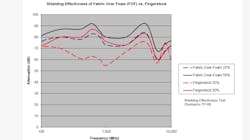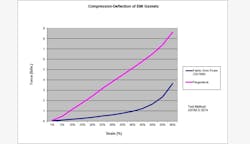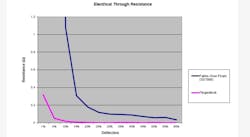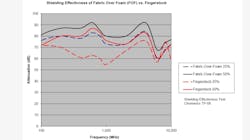Over the last 10 years, there has been a proliferation in the use of conductive fabric-over-foam gaskets for EMI shielding. Advances in plating adhesion, availability of UL 94V-0 flame-rated material, and profile design have made fabric-over-foam the gasket of choice for grounding and EMI shielding solutions in a majority of indoor electronics housing applications.
The predominant form of shielding prior to the growth of fabric-over-foam had been metal-spring fingers of either beryllium copper (Be/Cu) or stainless steel. Due to the lower cost and ease of installation of fabric-over-foam, its popularity has increased, especially in the high-volume, commercial electronics sector.
The more popular forms of fabric-over-foam include nickel-copper- or nickel-silver-plated nylon woven or nonwoven fabric wrapped around a urethane foam core. Generally, the foam is a 3-lb or 4-lb density commercial-grade urethane that performs well enough in applications with few closure cycles or low shear activity.
However, fabric-over-foam is not well suited for applications where long-term performance at elevated temperature is crucial and compression set unacceptable. The performance of most urethane foams starts to degrade above 70°C. When most fabric-over-foam gaskets with urethane foam cores are tested for compression set according to ASTM D-3574, the results are in the 20% to 30% range. Tests performed on urethane bun samples may fare better but are not indicative of real-life situations.
When long-term gasket performance is critical, the default gasket tends to be fingerstock, usually made of Be/Cu. This gives adequate mechanical performance and, in most cases, sufficient shielding effectiveness to hold up to ETSI and NEBS test standards.
Regardless of the capabilities, there still is a case to be made for using fabric over a nonurethane foam. As an example, Chomerics has introduced a fabric-over-foam gasket using soft silicone foam that is particularly effective in extreme situations.
Case History
A major manufacturer of enterprise and carrier networking equipment submitted products to its test lab for a battery of NEBS and ETSI tests. EMI gaskets of silver-copper-plated cloth jacket over urethane were used as shielding on the edges of the rack-mounted power supply and switch.
Among the ETSI tests performed on the equipment was ETS 300 019-2-2, an environmental test that simulates extreme temperatures during transportation of telecommunications equipment. Part of this test requires elevating the temperature in the test chamber housing the unpackaged equipment to 85°C for six hours.
After the test was performed, the test lab attempted to remove the power supply module. Unfortunately, the urethane foam had melted, seeped through the jacket, and stuck to the mating flange.
This was unacceptable for several reasons; most obviously, the gasket would have to be scrapped. Also, urethane leaking through the jacket onto the mating flange decreases the conductivity of the cloth jacket on the gasket.
Solution
The urethane-based gaskets were replaced with our silicone foam-based SOFT-SHIELD® 7000. The equipment was resubmitted for the ETS 300 019-2-2 test and passed. The gaskets did not exhibit any degradation, even with 85°C temperatures.
The processes used to develop and manufacture the replacement gasket were crucial to obtain the deflection characteristics similar to urethane-based fabric-over-foam. We were able to customize the silicone foam to achieve lower force deflection than is available in commercial-grade silicone-foam forms. Typical compression set for the gaskets is 1% to 2% when tested to 70°C and less than 10% when tested to 125°C.
The alternative to a fabric-over-foam gasket would be metal fingerstock. However, in most forms, Be/Cu fingerstock is much stiffer. To demonstrate this, Figure 1 compares force-deflection curves of a Be/Cu fingerstock profile (D-shape 0.120² × 0.400²) and a comparably shaped SOFT-SHIELD 7000 fabric-over-foam profile. The pressure required to deflect fingerstock for a particular application must be considered, especially in line-card applications where the buildup of pressure can be significant.
EMI shielding effectiveness is another design consideration when comparing fabric-over-foam to fingerstock. It often is thought that fingerstock shields better than fabric-over-foam. But as Figures 2 and 3 show, better through-resistance does not always equate to better shielding. The gasket shapes are the same as those used in Figure 1.
While the shielding results represented in Figures 2 and 3 may seem illogical since solid metal is more conductive than plated fabric, consider the following factors:
- As a fabric-over-foam gasket is compressed, more of the surface area of the gasket contacts the mating flange, allowing for reduction in the ground path resistance. This is not always the case with metal gaskets, especially with stiffer versions. The actual flange contact point at the top of the gasket remains relatively narrow until highly compressed.
- Another factor to consider is the array of slots found in most spring-finger gaskets. Slots are designed to help take up gap tolerances in the flange, reduce the force needed to deflect the gasket, and ensure uniform contact across a flange. Unfortunately, as frequencies increase, so do the chances for leakage through these slots. Fingerstock with lower-force deflection characteristics is available but commonly is constructed with thinner metal, which is more prone to catching and breaking.
- In addition to excellent shielding, fabric-over-foam gaskets provide air sealing and ease of installation.
- Cost, in most cases, will be less for fabric-over-foam than for Be/Cu fingerstock in similar profiles.
- When shear forces are a concern, options with fabric-over-foam can be used to get the same physical performance as fingerstock. Grooves can be designed into flanges to reduce insertion forces on gaskets. Uniquely shaped fabric-over-foam gaskets also are available for use on flat flange surfaces that will work very well in shear applications.
Conclusions
All of these considerations were important to the engineers involved in this case history. The equipment had been designed with a fabric-over-foam EMI gasket in mind. Although fingerstock could have been made to fit, it was preferable to drop in a fabric-over-foam gasket that fit and could withstand environmental stresses.
In summary, the availability of new, high-performance foam has expanded the applications available for fabric-over-foam EMI gaskets. This allows more flexibility when designing gaskets for business-critical computing equipment and telecommunications equipment that must be tested to NEBS and ETSI standards.
About the Author
Gardner Bradlee is a market manager at Chomerics and has been with the company since 1997. Mr. Bradlee received a B.A. in economics/Asian studies from Connecticut College and holds an M.B.A. from the Olin School of Management at Babson College. Chomerics Division of Parker Hannifin, 77 Dragon Court, Woburn, MA 01888, 781-939-4275, e-mail: [email protected]
FOR MORE INFORMATION
on EMI gaskets for wireless applications
www.rsleads.com/306ee-185
Return to EE Home Page
Published by EE-Evaluation Engineering
All contents © 2003 Nelson Publishing Inc.
No reprint, distribution, or reuse in any medium is permitted
without the express written consent of the publisher.
June 2003




